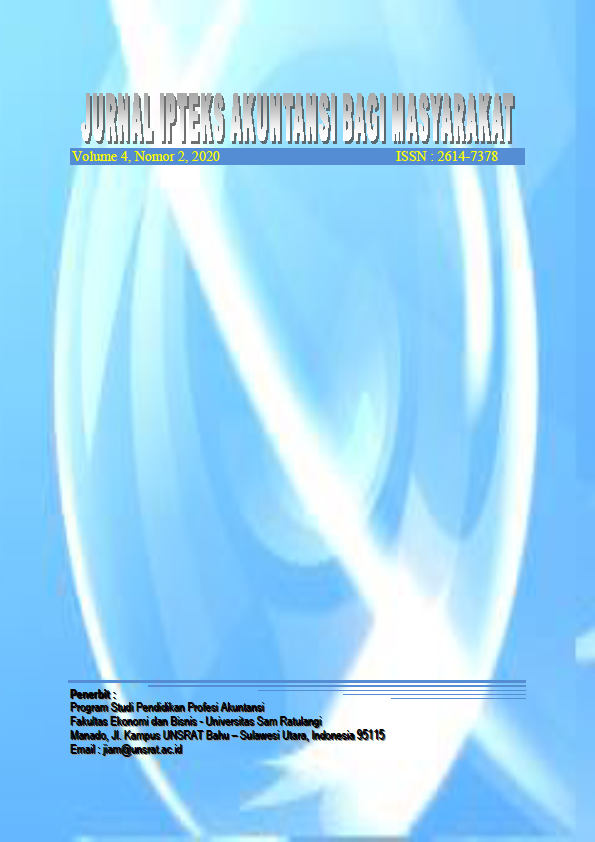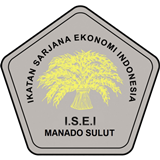IPTEKS PERENCANAAN LABA KONTRIBUSI PADA USAHA MANUFAKTUR
DOI:
https://doi.org/10.32400/jiam.4.2.2020.31106Keywords:
contribution margin, total cost, fixed cost, variable costAbstract
The manufacturing firms have implicit and explicit goals and objectives. In order to achieve these goal and objective then manager needs accounting information. The accounting information created and used by management is intended primarily for planning and control decisions. One of the accounting information is cost accounting that can be used as a tool for planning the profit as the objective of the companies. Manufacturing costs are identified as variable costs or fixed costs under cost behavior analysis. Regression analysis is the one of the cost estimation methods in term to estimate the fixed costs and variable costs where the results of estimation are used to calculate the contribution margin.
References
Balakrishnan, R., Sivaramakrishnan, K., & Sprinkle, G. B. (2012). Managerial accounting, Second Edition. United States of America: John Wiley & Sons, Inc.
Bhimani, A., Horngren, C. T., Datar, S. M., & Rajan, M. V. (2019). Management and cost accounting. Seventh Edition. United Kingdom: Pearson Education Limited.
Bluman, A. G. (2012). Elementary statistics: A step by step approach, Eighth Edition. New York: McGraw-Hill.
Braun, K., & Tietz, W. M. (2015). Managerial accounting, Fourth Edition. England: Pearson Education Limited.
Budiarso, N. S. (2019). Ipteks estimasi biaya bagi usaha kecil menengah dalam perencanaan biaya. Jurnal Ipteks Akuntansi bagi Masyarakat, 3(1). 29-34. https://doi.org/10.32400/jiam.3.1.2019.23306
Darroch, J. (2005). Knowledge management, innovation and firm performance. Journal of Knowledge Management, 9(3). 101-115. https://doi.org/10.1108/13673270510602809
Fry, G. S. (2014). Business statistics a decision-making approach, Ninth Edition. United Kingdom: Pearson Education Limited.
Gravetter, F. J., Wallnau, L. B., & Forzano, L. A. B. (2018). Essentials of statistics for the behavioral sciences, Ninth Edition. United States of America: Cengage Learning.
Jensen, M. C., & Meckling, W. H. (1976). Theory of the firm: Managerial behavior, agency costs and ownership structure. Journal of Financial Economics 3(4). 305-360. https://www.sciencedirect.com/journal/journal-of-financial-economics/vol/3/issue/4
Lorenzon, J. R. F., Rubio, M. T. M., & Garcés, S. A. (2018). The competitive advantage in business, capabilities and strategy. What general performance factors are found in the Spanish wine industry? Wine Economics and Policy 7. 94–108. https://doi.org/10.1016/j.wep.2018.04.001
Hansen, D. R. & Mowen, M. M. (2007). Managerial accounting, 8th Edition. United States of America: Thomson South-Western.
Harris, P., & Mongiello, M. (2006). Accounting and financial management developments in the international hospitality industry. Burlington: Elsevier Ltd.
Horngren, C. T., Datar, S. M. & Rajan, M. V. (2015). Cost accounting: A managerial emphasis, Fifteenth Edition. England: Pearson Education Limited.
Lanen, W. N., Anderson, S. W., & Maher, M. W. (2014). Fundamentals of cost accounting, Fourth Edition. United States of America: McGraw-Hill/Irwin
Madhok, A. & Marques, R. (2014). Towards an action-based perspective on firm competitiveness. BRQ Business Research Quarterly, 17(2), 77-81. https://doi.org/10.1016/j.brq.2014.03.002
Ozuomba, C. N., Anichebe, A. S. & Okoye, P. V. C. (2016). The effect of dividend policies on wealth maximization-a study of some selected plcs. Cogent Business and Management, 3(1). 1-15. https://doi.org/10.1080/23311975.2016.1226457
Perreault, W. D., Cannon, J. P., & McCarthy, E. J. (2017). Essentials of marketing: A marketing strategy planning approach, 15th Edition. New York: McGraw-Hill Education
Ross, S. A., Westerfield, R. W., & Jordan, B. D. (2017). Essentials of corporate finance, Ninth Edition. New York: McGraw-Hill.
Sholihah, I. M., Syaparuddin, & Nurhayani. (2017). Analisis investasi sektor industri manufaktur, pengaruhnya terhadap pertumbuhan ekonomi dan penyerapan tenaga kerja di Indonesia. Jurnal Paradigma Ekonomika, 12(1). 11-24. https://online-journal.unja.ac.id/paradigma/issue/view/599
Silviu, C. G., & Timea, F. M. (2015). New audit reporting challenges auditing the going concern basis of accounting. Procedia Economics and Finance 32, 216 – 224
Weerawardena, J., & O’Cass, A. (2004). Exploring the characteristics of the market-driven firms and antecedents to sustained competitive advantage. Industrial Marketing Management 33(5). 419-428. https://www.sciencedirect.com/journal/industrial-marketing-management/vol/33/issue/5
Weygandt, J. J., Kimmel, P. D., & Kieso, D. E. Managerial accounting tools for business decision making, Eight Edition. United States of America: John Wiley & Sons.
Whitecotton, S., Libby, R. & Phillips, F. (2020). Managerial accounting, Fourth Edition. Unites States of America: McGraw-Hill Education
Wild, J. J., Shaw, K. W., & Chiappetta, B. (2018). Financial and managerial accounting: Information for decisions, 7th Edition. New York: McGraw-Hill Education,
Yuan, F. C. (2009). The use of a fuzzy logic-based system in cost-volume-profit analysis under uncertainty. Expert Systems with Applications 36. 1155–1163. https://www.sciencedirect.com/science/article/abs/pii/S0957417407005738
Yovalia, S., & Wibowo, W. (2016). Pengaruh business strategy dan business risk terhadap going concern pada perusahaan manufaktur yang terdaftar di BEI tahun 2010-2014. Jurnal Akuntansi Trisakti, 3(2), 177-192. http://dx.doi.org/10.25105/jat.v3i2.4962
Downloads
Additional Files
Published
Issue
Section
License
Authors who publish with this journal agree to the following terms:
- Authors retain copyright and grant the journal right of first publication with the work simultaneously licensed under a Creative Commons Attribution License that allows others to share the work with an acknowledgement of the work's authorship and initial publication in this journal.
- Authors are able to enter into separate, additional contractual arrangements for the non-exclusive distribution of the journal's published version of the work (e.g., post it to an institutional repository or publish it in a book), with an acknowledgement of its initial publication in this journal.
- Authors are permitted and encouraged to post their work online (e.g., in institutional repositories or on their website) prior to and during the submission process, as it can lead to productive exchanges, as well as earlier and greater citation of published work (See The Effect of Open Access).







